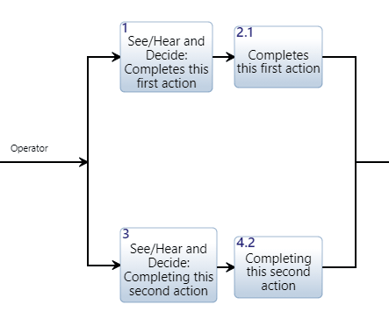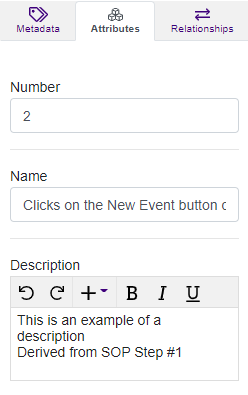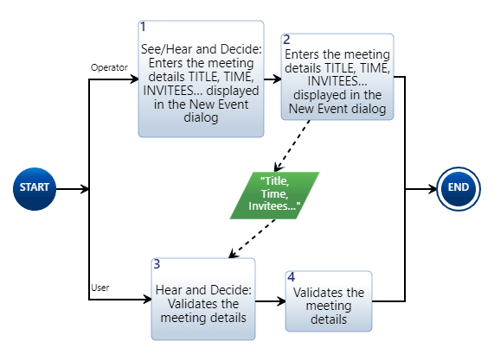Standard Operating Procedure (SOP) File
Create a strong and well-structured SOP File.
Outline

A well-formatted SOP document starts with a title at the top, followed by a numbered list of procedures. Each step in the procedure is written, in English, as one sentence per line, and ends with a period. The only exception to the latter is when adding a description, which will be discussed in a later section. In Sopatra, the SOP document must be either a .docx or .txt file.
Sopatra-Generated Action Diagram
For every step in the SOP document, two Procedure entities (subclass of Action) are created on the Operator branch in the Sopatra-generated action diagram. The first Procedure is a “See/Hear and Decide” cue, signaling the Actor’s need to validate either a visual or auditory cue from the surrounding environment before acting on the subsequent Procedure. The second Procedure is derived directly from the current SOP step being processed. Actors and Procedures will be discussed in further detail in the following sections.
The example SOP above was processed by Sopatra into the action diagram below:

The pair of Procedures below demonstrates how the 1st step of the above SOP was translated into Procedures in the action diagram.

Sentence Structure
Each sentence representing a step in the SOP should follow the following structure:
- “Actor” + “Action” + “the rest of the sentence”.
The Actor must be a noun or noun phrase at the beginning of the sentence in title case-style where the first letter of each word in the Actor noun phrase must be capitalized (i.e. Project Manager). The Actor may have numbers in it, but should always lead with a capital letter. The first word in the action (verb phrase) following the Actor should begin with a lowercase letter.
For example:
- Project Manager clicks on the New Event button displayed by Outlook.
The Figure below highlights the Actors (Blue) and Actions (Pink) within each SOP step.

If the actor is referenced in any later part of the SOP, then always use the same actor name explicitly. Avoid using pronouns such as “they” or “it” as Sopatra will treat these as a separate noun from the Actor the pronoun refers to.
When

Sopatra handles uses of when in an SOP step uniquely. The assumption made using when in an SOP step is that the 1st part of the sentence (“Operator completes this second action”, highlighted in yellow above) depends on the 2nd part of the sentence (“Operator completes this first action”, highlighted in pink above), and thus occurs after the 2nd part.
Sopatra will split the sentence into two distinct sentences around the when, placing them in the action diagram in the same order as an I/O entity Then between them to indicate the proper sequence of events.

If the second actor is the same as the first, the Procedures will be placed on the same Actor branch, and the Then I/O will not connect to the 2nd Procedure since they’re on the same Actor branch.
One last important note regarding the use of when is the structure of the sentence it is being used in. When should always be followed by another Actor, even if it is the same Actor as the beginning of the SOP step. This rule keeps the generation of Action diagrams clean and correct, especially as it pertains to assigning the Procedures to the correct branches.
SOP Step: “Actor” + “Action Phrase” + “when” + “Actor” + “Action Phrase”.
When plays an important role in the execution of the SOP and its inclusion in SOP development is encouraged by the SOP community.
While

Similar to when, Sopatra handles uses of while in an SOP step uniquely. The assumption made using while in an SOP step is that the 1st part of the sentence (“Operator completes this first action”, highlighted in yellow above) occurs at the same time as the 2nd part of the sentence (“completing this second action”, highlighted in pink above), and thus occurs after the 2nd part.

One caveat regarding the use of while is the structure of the sentence it is being used. While should never be followed by another Actor, even if it is the same Actor in the beginning of the SOP step. This ensures the simultaneous actions are processed properly into Procedures.
SOP Step: “Actor” + “Action and sentence” + “while” + “Action and sentence”.
Note: There are several other words/phrases that trigger this same behavior. The full list is as follows:
- all the while
- and simultaneously
- at the same moment
- at the same time
- at the same time as
- concurrently
- meanwhile
- simultaneously
- while
- whilst
Descriptions
Descriptions may be added to the SOP Steps once they are generated as Procedure entities in the Sopatra action diagram. There are two methods of adding a description along with an SOP step:
- Add the description within parentheses to the end of the SOP, just before the period.
- Add the description as a Note in the line following the SOP step. This is the only line in the SOP that does not require a period at the end.
- Note, choosing not to number your Notes can simplify the process and keep things straightforward. However, if you decide to assign numbers to the Note line, kindly ensure that the number concludes with a period to help the parser accurately number the actions (examples below)

Recalling the original example SOP, the notes being added to the Procedure description are highlighted in green.
In this example, the highlighted notes section in the 1st SOP step would be added to that Procedure’s description while the Note line in the 4th SOP step would be added to the description of the 3rd SOP step.

Note: The Note line also includes a colon (:). Leaving this out of that statement results in Sopatra treating Note as another Actor.
Adding a Note line before the 1st SOP step will add that line to the description of the root Procedure of the action diagram.
I/Os
Words surrounded by double quotes within the SOP step are created as Input/Output (I/O) entities within the Sopatra generated Action diagram. The Figure below is an example of the double quote usage, highlighted yellow, within an SOP step.

Sopatra creates an I/O entity for the text in quotes and leaves that text in all caps in the Procedure entity that was created for the SOP step.

Subscripts and Superscripts
Sopatra cannot maintain the formatting of subscripts and superscripts on import. If a subscript or superscript is included in an SOP document, then Sopatra will treat it as regular text.
For example, X2 is parsed as X2, and EA is parsed as EA.
If you are using Microsoft Word and wish to add subscripts or superscripts, use the buttons under the ‘Home’ tab to ensure they get brought in by Sopatra. Adding the subscripts or superscripts through other methods may result in the text being ignored by Sopatra.

Supporting Documents
To enhance the SOP development process, Sopatra makes use of several (optional but recommended) other supporting documents, including Input Devices, Output Displays, Time Distribution Database, and Acronyms. Click the name of the document you wish to learn more about to navigate to that file’s formatting and information guide page.
To continue learning about Sopatra Import Requirements, Click Here.
(Next Article: Time Distribution Database File)
